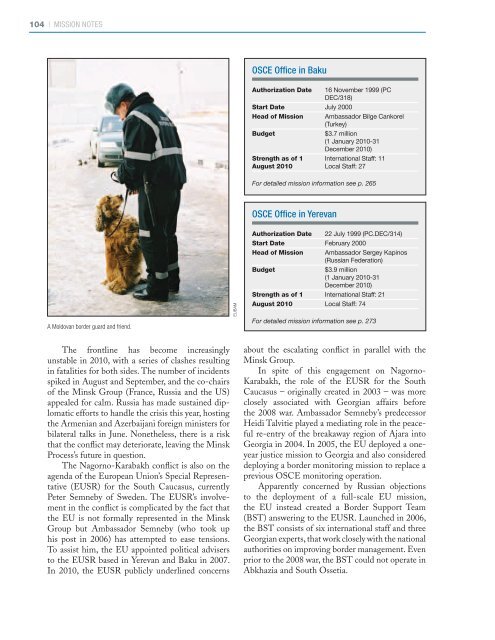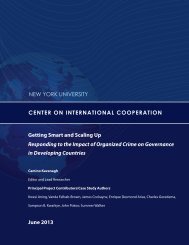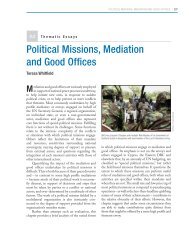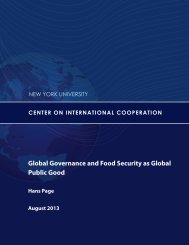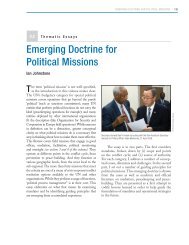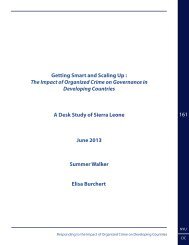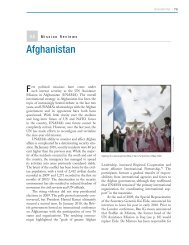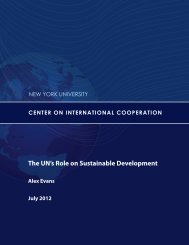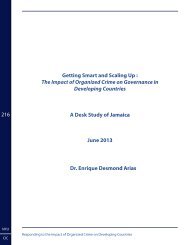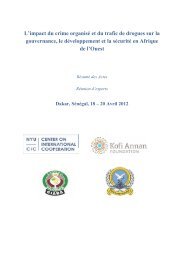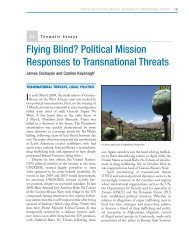- Page 1 and 2:
Review ofPolitical2010MissionsA Pro
- Page 3 and 4:
This volume is a product of the <st
- Page 5 and 6:
© 2010 by Xanthus Design. All righ
- Page 7 and 8:
vi | Contents4 Mission Notes 1 1014
- Page 10 and 11:
ForewordAs the United Nations and i
- Page 12 and 13:
PrefaceThe Center
- Page 14 and 15:
Preface | xiiiwith information on i
- Page 16:
Mission AcronymsBINUBBINUCACNMCEUBA
- Page 20 and 21:
Strategic Summary 1Richard Gowan1
- Page 22 and 23:
STRATEGIC SUMMARY | 3involved in ef
- Page 24 and 25:
STRATEGIC SUMMARY | 5The fact that
- Page 26 and 27:
Thematic Essays 2All Peace Operatio
- Page 28 and 29:
All Peace Operations are Political
- Page 31 and 32:
12 | Thematic EssaysThe handicap of
- Page 33 and 34:
14 | Thematic EssaysCouncil, the Pe
- Page 35:
16 | Thematic EssaysMandatesScopeTh
- Page 39 and 40:
20 | Thematic EssaysEmerging Doctri
- Page 41 and 42:
22 | Thematic EssaysSource of Autho
- Page 43 and 44:
24 | Thematic Essaysin the mandate:
- Page 45 and 46:
26 | Thematic Essays19 In the case
- Page 47 and 48:
28 | Thematic EssaysThe utility of
- Page 49 and 50:
30 | Thematic Essaysa political act
- Page 51 and 52:
32 | Thematic Essayssupporting medi
- Page 54 and 55:
Mission Reviews 33.1 Middle East3.2
- Page 56 and 57:
Middle East | 37Peace Process (UNSC
- Page 58 and 59:
Middle East | 39implementation of t
- Page 60 and 61:
Middle East | 41Recent Developments
- Page 62 and 63:
Middle East | 43Special Envoy for t
- Page 64 and 65:
West Africa | 453.2M i s s i o n R
- Page 66 and 67:
West Africa | 47Key DevelopmentsSev
- Page 68 and 69:
West Africa | 49UNOWABackgroundThe
- Page 70 and 71:
West Africa | 51The Cameroon-Nigeri
- Page 72 and 73: West Africa | 53“A Shared Vision
- Page 74: West Africa | 55they have the poten
- Page 77 and 78: 58 | Mission ReviewsChild in a rebe
- Page 79 and 80: 60 | Mission ReviewsUN Integrated O
- Page 81 and 82: 62 | Mission Reviewsaccountability
- Page 84 and 85: Western Balkans | 653.4 M i s s i o
- Page 86 and 87: Western Balkans | 67Since its found
- Page 88 and 89: Western Balkans | 69OSCE Mission in
- Page 90 and 91: Western Balkans | 71OSCE officials,
- Page 92 and 93: Western Balkans | 73Men wave EU and
- Page 94 and 95: Afghanistan | 753.5M i s s i o n R
- Page 96 and 97: Afghanistan | 77Security Council Sa
- Page 98 and 99: Afghanistan | 79the population does
- Page 100 and 101: Afghanistan | 81The EUIn 2001, the
- Page 102 and 103: IRAQ | 833.6 M i s s i o n R e v i
- Page 104 and 105: Iraq | 85of representatives from bo
- Page 106 and 107: Iraq | 87Staffing and the 2009 Huma
- Page 108 and 109: Nepal | 893.7 M i s s i o n R e v i
- Page 110 and 111: Nepal | 91but they had prescribed p
- Page 112: Nepal | 932009 and the impasse that
- Page 115 and 116: 96 | Mission ReviewsUN Political Of
- Page 117 and 118: 98 | Mission Reviewsits capacity to
- Page 119 and 120: 100 | Mission Reviews- be it a peac
- Page 121: 102 | Mission Notes4.1M i s s i o n
- Page 125 and 126: 106 | Mission Notesand Moldova (unu
- Page 127 and 128: 108 | Mission NotesOAS Mission to S
- Page 129 and 130: 110 | Mission NotesThe mission is c
- Page 131 and 132: 112 | Mission NotesPerm'CENTRAL ASI
- Page 133 and 134: 114 | Mission NotesThe OSCE and EUT
- Page 136 and 137: Myanmar | 1174.4M i s s i o n N o t
- Page 138 and 139: Myanmar | 119such releases, and arb
- Page 140: Myanmar | 121instability for Myanma
- Page 143 and 144: 124 | Mission NotesPersonal Envoy,
- Page 145 and 146: 126 | Mission Notesthe parties. Aga
- Page 147 and 148: 128 | REVIEW OF POLITICAL MISSIONS5
- Page 149 and 150: 130 | REVIEW OF POLITICAL MISSIONSN
- Page 151 and 152: 132 | REVIEW OF POLITICAL MISSIONSI
- Page 153 and 154: 134 | REVIEW OF POLITICAL MISSIONSB
- Page 155 and 156: 136 | REVIEW OF POLITICAL MISSIONSS
- Page 157 and 158: 138 | REVIEW OF POLITICAL MISSIONSC
- Page 160 and 161: UN6Mission-by-Mission Statistics6.1
- Page 162 and 163: UN MISSION-BY-MISSION STATISTICS |
- Page 164 and 165: BINUB | 145BINUB Personnel Gender S
- Page 166 and 167: BINUB | 147BINUB Requirements: Jan
- Page 168 and 169: UN MISSION-BY-MISSION STATISTICS |
- Page 170 and 171: BINUCA (formerly BONUCA) | 151BINUC
- Page 172 and 173:
BINUCA (formerly BONUCA) | 153BINUC
- Page 174 and 175:
BINUCA (formerly BONUCA) | 155BONUC
- Page 176 and 177:
CNMC | 157CNMC Personnel Gender Sta
- Page 178 and 179:
CNMC | 159CNMC Budget and Expenditu
- Page 180 and 181:
Personal Envoy, Western Sahara | 16
- Page 182 and 183:
UN MISSION-BY-MISSION STATISTICS |
- Page 184 and 185:
SPECIAL ADVISER, CYPRUS | 165Specia
- Page 186 and 187:
SPECIAL ADVISER, CYPRUS | 167Specia
- Page 188 and 189:
SPECIAL ADVISER, MYANMAR | 169Speci
- Page 190 and 191:
UN MISSION-BY-MISSION STATISTICS |
- Page 192 and 193:
SPECIAL ENVOY, IMPLEMENTATION OF RE
- Page 194 and 195:
SPECIAL ENVOY, LRA-AFFECTED AREAS |
- Page 196 and 197:
UN MISSION-BY-MISSION STATISTICS |
- Page 198 and 199:
UNAMA | 179UNAMA Fatalities: 30 Apr
- Page 200 and 201:
UNAMA | 181UNAMA Budget and Expendi
- Page 202 and 203:
UN MISSION-BY-MISSION STATISTICS |
- Page 204 and 205:
UNAMI | 185UNAMI Fatalities: 30 Apr
- Page 206 and 207:
UNAMI | 187UNAMI Budget and Expendi
- Page 208 and 209:
UN MISSION-BY-MISSION STATISTICS |
- Page 210 and 211:
UNIIIC | 191UNIIIC Expenditures: Ja
- Page 212 and 213:
UNIOGBIS (formerly UNOGBIS) | 193UN
- Page 214 and 215:
UNIOGBIS (formerly UNOGBIS) | 195UN
- Page 216 and 217:
UN MISSION-BY-MISSION STATISTICS |
- Page 218 and 219:
UNIPSIL | 199UNIPSIL Fatalities: 30
- Page 220 and 221:
UNIPSIL | 201UNIPSIL Estimated Expe
- Page 222 and 223:
UNMIN | 203UNMIN International Civi
- Page 224 and 225:
UNMIN | 205UNMIN Requirements: Dec
- Page 226 and 227:
UN MISSION-BY-MISSION STATISTICS |
- Page 228 and 229:
UNOWA | 209UNOWA/CNMC Aircraft: 31
- Page 230 and 231:
UN MISSION-BY-MISSION STATISTICS |
- Page 232 and 233:
UNPOS | 213UNPOS Aircraft: 31 March
- Page 234 and 235:
UNPOS | 215UNPOS Estimated Expendit
- Page 236 and 237:
UNRCCA | 217UNRCCA International Ci
- Page 238 and 239:
UNRCCA | 219UNRCCA Budget and Expen
- Page 240 and 241:
UNSCO | 221UNSCO International Civi
- Page 242 and 243:
UN MISSION-BY-MISSION STATISTICS |
- Page 244 and 245:
UNSCOL | 225UNSCOL Requirements: Ja
- Page 246 and 247:
OSCEMission-by-Mission Statistics77
- Page 248 and 249:
OMIK | 229OMIK Personnel by Post Ja
- Page 250 and 251:
OMIK | 231OMIK Personnel by Post Ja
- Page 252 and 253:
OMIK | 233OMIK Personnel by Post Ja
- Page 254 and 255:
OMIK | 235OMIK Budget Jan ‘99-Dec
- Page 256 and 257:
OSCE BiH | 237OSCE BiH Personnel by
- Page 258 and 259:
OSCE BiH | 239OSCE BiH Personnel by
- Page 260 and 261:
OSCE BiH | 241OSCE BiH Budget Jan
- Page 262 and 263:
OSCE Centre in Ashgabat | 243OSCE C
- Page 264 and 265:
OSCE Centre in Ashgabat | 245OSCE C
- Page 266 and 267:
OSCE Centre in Astana | 247OSCE Cen
- Page 268 and 269:
OSCE Centre in Astana | 249OSCE Cen
- Page 270 and 271:
OSCE Centre in Bishkek | 251OSCE Ce
- Page 272 and 273:
OSCE Centre in Bishkek | 253OSCE Ce
- Page 274 and 275:
OSCE Mission to Moldova | 255OSCE M
- Page 276 and 277:
OSCE Mission to Moldova | 257OSCE M
- Page 278 and 279:
OSCE Mission to Montenegro | 259OSC
- Page 280 and 281:
OSCE MISSION-BY-MISSION STATISTICS
- Page 282 and 283:
OSCE Mission to Serbia | 263OSCE Mi
- Page 284 and 285:
OSCE MISSION-BY-MISSION STATISTICS
- Page 286 and 287:
OSCE Office in Baku | 267OSCE Offic
- Page 288 and 289:
OSCE MISSION-BY-MISSION STATISTICS
- Page 290 and 291:
OSCE Office in Tajikistan | 271OSCE
- Page 292 and 293:
OSCE MISSION-BY-MISSION STATISTICS
- Page 294 and 295:
OSCE Office in Yerevan | 275OSCE Of
- Page 296 and 297:
OSCE MISSION-BY-MISSION STATISTICS
- Page 298 and 299:
OSCE Presence in Albania | 279OSCE
- Page 300 and 301:
OSCE MISSION-BY-MISSION STATISTICS
- Page 302 and 303:
OSCE Spillover Mission to Skopje |
- Page 304 and 305:
OSCE Spillover Mission to Skopje |
- Page 306 and 307:
CiO Representative on Minsk Confere


